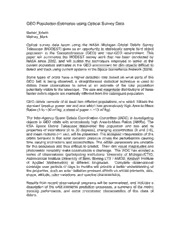
NASA Technical Reports Server (NTRS) 20070017988: GEO Population Estimates using Optical Survey Data PDF
Preview NASA Technical Reports Server (NTRS) 20070017988: GEO Population Estimates using Optical Survey Data
GEO Population Estimates using Optical Survey Data Barker_Edwin Matney_Mark Optical survey data taken using the NASA Michigan Orbital Debris Survey Telescope (MODEST) gives us an opportunity to statistically sample faint object population in the Geosynchronous (GEO) and near-GEO environment. This paper will summarize the MODEST survey work that has been conducted by NASA since 2002, and will outline the techniques employed to arrive at the current population estimates in the GEO environment for dim objects difficult to detect and track using current systems in the Space Surveillance Network (SSN). Some types of orbits have a higher detection rate based on what parts of the GEO belt is being observed, a straightforward statistical technique is used to debias these observations to arrive at an estimate of the total population potentially visible to the telescope. The size and magnitude distributions of these fainter debris objects are markedly different from the catalogued population. GEO debris consists of at least two different populations, one which follows the standard breakup power law and one which has anomalously high Area-to-Mass Ratios (1 to ~30 m2/kg; a sheet of paper = ~13 m2/kg). The Inter-Agency Space Debris Coordination Committee (IADC) is investigating objects in GEO orbits with anomalously high Area-to-Mass Ratios (AMRs). The ESA Space Debris Telescope discovered this population and has and its properties of inclinations (0 to 30 degrees), changing eccentricities (0 and 0.6), and mean motions (~1 rev), will be presented. The accepted interpretation of this orbital behavior is that solar radiation pressure drives the perturbations causing time varying inclinations and eccentricities. The orbital parameters are unstable for this population and thus difficult to predict. Their dim visual magnitudes and photometric variability make observations a challenge. The IADC has enlisted a series of observatories (participating institutions: University of Michigan/CTIO, Astronomical Institute University of Bern, Boeing LTS / AMOS, Keldysh Institute of Applied Mathematics) at different longitudes. Complete observational coverage over periods of days to months will provide a better understanding of the properties, such as solar radiation pressure effects on orbital elements, size, shape, attitude, color variations, and spectral characteristics. Results from recent observational programs will be summarized, and includes a description of the orbit elements prediction processes, a summary of the metric tracking performance, and some photometric characteristics of this class of debris.
